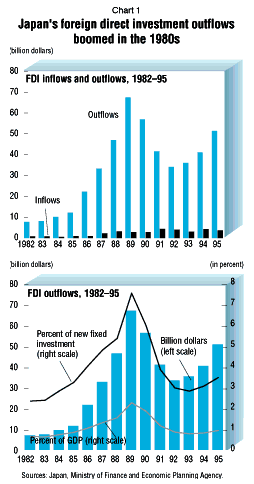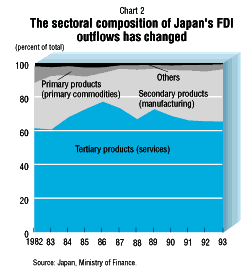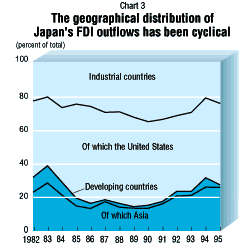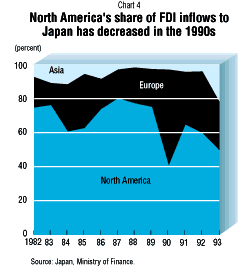Japanese Foreign Direct Investment and Regional Trade
Tamim bayoumi and Gabrielle Lipworth
Finance and Development/September 1997
Japan's foreign direct investment abroad has boomed over the past decade as many
Japanese companies have set up production facilities overseas. What impact has this had on
Japan's manufacturing sector and trade patterns, and is it likely to continue?
Overview
What is driving FDI?
FDI and trade
Conclusion
Japanese investment in companies abroad has surged since the early 1980s, sparking
debate on whether the Japanese economy is "hollowing out." Flows of foreign
direct investment (FDI) from Japan to other countries have been much larger than the
equivalent flows into Japan. This has aroused concerns that Japan's manufacturing base is
being eroded as productive capacity is moving abroad, hurting domestic growth and
employment.
The relocation of Japanese production abroad has also been connected to changes in
Japan's trade structure. While short-term changes in trade volumes and prices are due
largely to movements in relative prices and income, deeper underlying trends in Japan's
current account may well reflect structural changes in exports and imports. Certainly,
part of the decline in the trade balance from 1994 to mid-1996 appears to reflect the
growth of exports of capital- and technology-intensive goods, and an increase in the share
of manufactured goods in imports--and, in particular, an expansion of "reverse
imports" from Japanese affiliates abroad.
Such trends raise a number of questions:
- What have been the main factors driving the rapid growth of Japanese FDI? Is this growth
the result of a secular process of industrial restructuring as Japan's economy matures,
cyclical factors, or both?
- To what extent can the regional and sectoral composition of Japanese FDI outflows be
explained by macroeconomic factors? How do Japanese FDI and trade in East Asia compare
with Japanese FDI and trade in other regions?
- How has Japanese FDI affected Japan's trade structure and external balance?
- With a weaker yen, is the relocation of Japanese manufacturing abroad likely to
continue?
Overview
Three aspects of Japanese FDI since the early 1980s are particularly striking. First,
outflows have exceeded inflows by more than a factor of 10--indeed, this gap has been
growing. Second, outflows of Japanese FDI have shown a cyclical pattern that reflects
movements in the yen as well as factors affecting activity in Japan and its major trading
partners. Third, the sectoral and regional composition of FDI outflows have changed
significantly.
Outbound Japanese FDI rose from 2.5 percent to 3 percent of domestic investment between
1982 and 1993 (prior to 1982, Japanese FDI was heavily regulated and hence not as subject
to market forces), while inflows to Japan have remained approximately constant, at about
0.2 percent of Japan's domestic fixed investment. By 1993, the stock of Japanese FDI
abroad stood at $422.5 billion--almost fifteen times the $29.9 billion stock of FDI
received by Japan.
| Outbound Japanese FDI has shown a cyclical pattern. In the first half of
the 1980s, overseas investment increased briskly--in part to enable Japan to avoid trade
frictions with Europe and North America in the automobile sector--to reach $12.2 billion
in 1985 (around 1 percent of Japan's GDP). Growth accelerated further in the second half
of the decade, most likely because of booming economies at home and abroad, and the
appreciation of the yen. Japan's FDI outflows for 198689 surpassed the country's total
overseas investment for the entire postwar period up to 1986. By the late 1980s, Japan was
investing more abroad than any other country in the world, with its FDI peaking at $67.5
billion (around 2.5 percent of GDP) in 1989. This boom in Japanese FDI ended abruptly in
the early 1990s when the asset-price bubble burst. For a few years, annual outflows
declined steadily, both in absolute terms and relative to GDP and fixed investment, as the
sharp decline in asset prices in 1990, which led to severe balance sheet difficulties for
many businesses and banks, triggered a deep and protracted economic slump. More recently,
FDI outflows have begun to recover, spurred by the appreciation of the yen in 199394 and
the spring of 1995 and a pickup in domestic investment. |
 |
| Coinciding with these cyclical movements have been notable changes in the
regional and sectoral composition of outbound FDI. Japanese companies sharply increased
their investment in North America in the 1980s. Indeed, during the 1980s, industrial
countries saw their share of Japanese FDI grow to more than 75 percent of the total (the
United States alone received 50 percent of total Japanese FDI), whereas developing
countries (including those in Asia) saw their share drop from 50 percent to about 25
percent. During this period, Japanese overseas investment in the tertiary
sectors--including finance, insurance, transport, and real estate--grew significantly,
while the share of FDI in manufacturing and mining declined. |
 |
| These trends have been partially reversed after the bursting of the asset-price
bubble. The share of Japanese FDI received by developing countries has returned to the
levels seen in the early 1980s--and the share received by Asian countries within this
total has increased substantially. At the same time, FDI flows to industrial
countries--particularly the United States --have decreased. The decline of Japanese
investment in the United States coincided with the decline in Japanese investment in
services, particularly real estate, while the corresponding increase in FDI outflows to
other countries in Asia has led to increased Japanese foreign investment in manufacturing,
particularly chemical products and machinery. |
 |
It is difficult to discern trends in the geographical
composition of FDI inflows to Japan given the small size and "lumpy" nature of
commitments (Chart 4). Flows from North America still account for the lion's share of FDI
into Japan, although this share seems to have decreased from around 75 percent in the late
1980s to 50 percent in the early 1990s. Flows from Europe have fluctuated but appear to
have risen slightly in the 1990s, while Asia's share has remained more or less constant at
about 5 percent. Sectorally, there has been a decline in FDI inflows into the
manufacturing sector in the 1990s, while investment in the service sector has gone up. |
 |
What is driving FDI?
The initial allocation of FDI flows across countries is normally determined by
microeconomic factors, such as the desire to exploit economies of scale, penetrate foreign
markets, or reap other benefits. Historically, for example, Japanese overseas investment
during the postwar period has been concentrated in natural resource extraction and
labor-intensive manufacturing. The former represents a form of backward vertical
integration that has enabled Japanese companies in the traded goods sector to secure
access to raw materials. Investment in manufacturing in neighboring Asian countries can
also be seen in this light; it has allowed Japanese companies to move production abroad in
a sector where Japan has been losing comparative advantage. More recently, increases in
FDI have been associated with the rapid growth of spending on research and development by
Japanese firms. Some Japanese FDI has also been triggered by policy actions that make it
advisable to move production of certain goods to other countries. Trade frictions, for
example, have stimulated flows of Japanese FDI to the United States and may have
encouraged Japanese firms to invest in Asia so as to build "export platforms"
for the US market.
While there is ample evidence in the academic literature of a link between FDI and
economies of scale owing to the ownership of knowledge and policy-induced distortions, a
microeconomic approach offers little insight into the cyclical volatility of FDI, nor can
it adequately explain differences in FDI across countries that exhibit similar
characteristics. For instance, foreign acquisitions in the United States fell by 60
percent in 1983 before more than doubling between 1986 and 1988, only to fall again by 30
percent between 1988 and 1990. Structural developments move too slowly to explain these
changes. To understand FDI fluctuations, it is necessary to look at more short-term,
cyclical factors, such as exchange rates, that affect costs and returns to investment.
While exchange rates can affect FDI in various ways, previous studies have generally
found that a depreciation of the host country's currency has a positive effect on FDI
inflows. A depreciation lowers the costs of production and investment in host countries
relative to the cost in source countries, making foreign investment more profitable. The
wealth effect is another channel through which a depreciation of the real exchange rate
can boost FDI--by increasing the relative wealth of foreign firms, a depreciation of the
real exchange rate can make it easier for those firms to use retained profits to finance
investment abroad.
Our empirical analysis looked at FDI outflows between Japan and 20 of its major trading
partners (Bayoumi and Lipworth, forthcoming). The results suggest that the main driving
forces for Japanese FDI are domestic investment and the exchange rate, but that the
investment climate of recipient countries influences the distribution of FDI.
The importance of domestic investment as a determinant of FDI is consistent with the
view that Japanese FDI generally complements domestic production. Japanese FDI appears to
be focused more on outsourcing than on providing an alternative location from which to
supply foreign markets. Higher demand for Japanese goods leads to parallel increases in
productive capacity at home and abroad. Thus, increases in domestic investment are
associated with increases in FDI--a 3.5 percent increase in Japanese investment generates
an increase in FDI of about 10 percent--while the impact of increases in host-country
investment is much more muted. In contrast, if foreign subsidiaries were being established
for the purpose of serving the local market in host countries--the purpose usually
ascribed to FDI from the United States and other industrial countries--FDI would be more
closely related to investment in the host country and domestic trends would be less
relevant. Strikingly, there is no evidence that flows to low-wage Asian countries behave
differently from flows to high-wage countries in North America and Europe, despite the
fact that the sectoral composition of FDI differs across countries.
Changes in the value of the yen also have a strong influence on the behavior of
Japanese FDI. In the short run, a 6 percent depreciation of the host country's currency
vis-à-vis the yen would also generate an increase in FDI of roughly 10 percent. While
Japan's total FDI has been driven mainly by domestic investment in Japan and
fluctuations in the exchange rate, the geographic distribution of Japanese FDI has been
influenced by economic conditions in recipient countries.
The short-term implication of these findings is that, although the depreciation of the
yen since mid-1995 would normally have caused Japanese FDI to decrease, FDI is being
stimulated by the growth of investment in Japan and in its partner countries, particularly
in Asia. Overall, therefore, Japanese FDI is likely to continue to grow moderately over
the next year or two.
FDI and trade
The shift of Japanese production abroad has stimulated imports from overseas
affiliates; in particular, the share of manufactured goods in total imports has grown. Our
analysis indicates that a higher stock of Japanese FDI has permanently affected
imports--between 1990 and 1995, outward FDI may have increased merchandise imports by
around 10 percent.
The relationship between FDI and exports is more complex. Our analysis shows that FDI flows
have a significant impact on exports but that the stock of FDI has no
significant effect. In other words, FDI has only a temporary impact on Japanese
exports--plausibly because new facilities set up by Japanese firms are often equipped
using capital goods from Japan. Once production overseas is on track, however, the
finished products that were once exported from Japan will be manufactured overseas. It is
difficult to determine a priori whether FDI results in a long-term rise or fall in total
exports, but the impact of FDI on the export structure is more clear-cut--exports of
capital goods rise and exports of consumer goods decline. And, of course, exports from
firms located abroad increase as their production increases.
Conclusion
Japanese firms are diversifying the location of their production and moving to other
countries those parts of their operations in which they are losing comparative advantage.
While the recent depreciation of the yen is likely to temper this process, Japanese FDI
outflows are part of a necessary restructuring of the Japanese economy, reflecting
globalization and economic growth in the rest of Asia. Despite the pain involved, such a
restructuring will produce a domestic economy better able to face the rigors of the world
economy in the future.
Tamim Bayoumi,
a British national, is a Senior Economist in the IMF's Asia and Pacific Department. |
Gabrielle Lipworth,
a South African national, is an Economist in the IMF's Asia and Pacific Department. |
This article is based on the authors' paper, "Japanese Foreign
Direct Investment and Regional Trade," which is forthcoming in the IMF's Working
Paper series.



